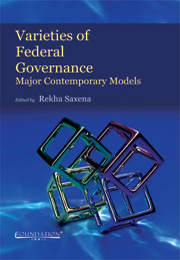Book contents
- Frontmatter
- Contents
- List of Contributors
- Foreword
- Acknowledgements
- Introduction
- I Theoretical and Comparative Dimensions
- II Presidential Federal Systems
- III Commonwealth Parliamentary Federations
- IV Non-Commonwealth Parliamentary Federations in Afro-Asia
- 13 Multi-ethnicity and Federalism: Constitutional Provisions in the Federal Democratic Republic of Ethiopia
- 14 Federalism and Political Inclusion: Choices facing Nepal
- V European Parliamentary Federations
- VI Devolutionary Systems
- VII Supranational Confederalism/Federalism?
14 - Federalism and Political Inclusion: Choices facing Nepal
from IV - Non-Commonwealth Parliamentary Federations in Afro-Asia
Published online by Cambridge University Press: 05 June 2012
- Frontmatter
- Contents
- List of Contributors
- Foreword
- Acknowledgements
- Introduction
- I Theoretical and Comparative Dimensions
- II Presidential Federal Systems
- III Commonwealth Parliamentary Federations
- IV Non-Commonwealth Parliamentary Federations in Afro-Asia
- 13 Multi-ethnicity and Federalism: Constitutional Provisions in the Federal Democratic Republic of Ethiopia
- 14 Federalism and Political Inclusion: Choices facing Nepal
- V European Parliamentary Federations
- VI Devolutionary Systems
- VII Supranational Confederalism/Federalism?
Summary
Introduction
Unlike other countries studied in this volume, Nepal is not yet a federal state. Nepal is now engaged in the drafting of a new constitution, which, it has already been decided, must provide for a democratic, federal state. Nepal is currently debating the form that federation will take. This chapter examines the circumstances that have given rise to the demand for federalism, and the kind of choices facing Nepali in designing a federal system.
Nepal is poised to adopt a new constitution which could provide the framework for dealing with the problems of exclusion, including political participation, which have been so prominent in the national agenda since the People's Movement of 2006. The Constituent Assembly (CA) was elected in April 2008 to draft and adopt a new constitution, within two years of its first meeting, which took place in May 2008. The CA has an unrestricted mandate under the Interim Constitution (IC) to decide on the values, principles and institutions for inclusion in the constitution, except in two important respects – firstly that the CA had to ‘implement’ a republic at its first meeting (Article 159, amended on 28 December 2007), and secondly that Nepal must become a ‘progressive democratic federation’ (Article 138, as amended on 13th April 2007).
The details of the federal system are not spelled out, but the purpose of moving to a federal system is clearly stated.
- Type
- Chapter
- Information
- Varieties of Federal GovernanceMajor Contemporary Models, pp. 282 - 312Publisher: Foundation BooksPrint publication year: 2011

